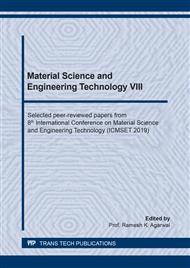[1]
E. D. Boland, K. J. Pawlowski, C. P. Barnes, D. G. Simpson, G. E. Wnek, and G. L. Bowlin, Electrospinning of Bioresorbable Polymers for Tissue Engineering Scaffolds,, 2006, p.188–204.
DOI: 10.1021/bk-2006-0918.ch014
Google Scholar
[2]
A. K. Gaharwar et al., Nanoclay-enriched poly(€-caprolactone) electrospun scaffolds for osteogenic differentiation of human mesenchymal stem cells,, Tissue Eng. - Part A, vol. 20, no. 15–16, p.2088–2101, Aug. (2014).
DOI: 10.1089/ten.tea.2013.0281
Google Scholar
[3]
Y. Wang, G. A. Ameer, B. J. Sheppard, and R. Langer, A tough biodegradable elastomer,, Nat. Biotechnol., vol. 20, no. 6, p.602–606, (2002).
DOI: 10.1038/nbt0602-602
Google Scholar
[4]
H. M. Aydin, K. Salimi, Z. M. O. Rzayev, and E. Pişkin, Microwave-assisted rapid synthesis of poly(glycerol-sebacate) elastomers,, Biomater. Sci., vol. 1, no. 5, p.503–509, May (2013).
DOI: 10.1039/c3bm00157a
Google Scholar
[5]
S. Sant, C. M. Hwang, S.-H. Lee, and A. Khademhosseini, Hybrid PGS-PCL microfibrous scaffolds with improved mechanical and biological properties.,, J. Tissue Eng. Regen. Med., vol. 5, no. 4, p.283–91, Apr. (2011).
DOI: 10.1002/term.313
Google Scholar
[6]
N. Bitinis, M. Hernandez, R. Verdejo, J. M. Kenny, and M. A. Lopez-Manchado, Recent advances in clay/polymer nanocomposites,, Adv. Mater., vol. 23, no. 44, p.5229–5236, Nov. (2011).
DOI: 10.1002/adma.201101948
Google Scholar
[7]
A. K. Solarajan, V. Murugadoss, and S. Angaiah, Montmorillonite embedded electrospun PVdF–HFP nanocomposite membrane electrolyte for Li-ion capacitors,, Appl. Mater. Today, vol. 5, p.33–40, Dec. (2016).
DOI: 10.1016/j.apmt.2016.09.002
Google Scholar
[8]
S. W. Kim, S. O. Han, I. N. Sim, J. Y. Cheon, and W. H. Park, Fabrication and characterization of cellulose acetate/montmorillonite composite nanofibers by electrospinning,, J. Nanomater., vol. 2015, (2015).
DOI: 10.1155/2015/275230
Google Scholar
[9]
X. Li, A. T.-L. Hong, N. Naskar, and H.-J. Chung, Criteria for Quick and Consistent Synthesis of Poly(glycerol sebacate) for Tailored Mechanical Properties.,, Biomacromolecules, vol. 16, no. 5, p.1525–33, May (2015).
DOI: 10.1021/acs.biomac.5b00018
Google Scholar
[10]
T. Abudula et al., The Effect of Poly (Glycerol Sebacate) Incorporation within Hybrid Chitin-Lignin Sol-Gel Nanofibrous Scaffolds.,, Mater. (Basel, Switzerland), vol. 11, no. 3, Mar. (2018).
DOI: 10.3390/ma11030451
Google Scholar
[11]
J. Zhu, Q. Zhang, J. Zheng, S. Hou, S. Zhang, and S. Li, Correlation of the polymer hydrophilicity and membrane fabrication process on the properties of asymmetric membranes in a vapor-induced phase-inversion process,, J. Appl. Polym. Sci., vol. 134, no. 15, Apr. (2017).
DOI: 10.1002/app.44701
Google Scholar
[12]
A. M. Slavutsky, M. A. Bertuzzi, and M. Armada, Water barrier properties of starch-clay nanocomposite films,, Brazilian J. Food Technol., vol. 15, no. 3, p.208–218, Sep. (2012).
DOI: 10.1590/s1981-67232012005000014
Google Scholar
[13]
R. H. A. Haq, M. S. Bin Wahab, and M. U. Wahit, Impact test and bioactivity properties of polycaprolactone (PCL) by addition of nano-montmorillonite (MMT) and hydroxyapatite (HA),, in Applied Mechanics and Materials, 2014, vol. 446–447, p.1129–1133.
DOI: 10.4028/www.scientific.net/amm.446-447.1129
Google Scholar


